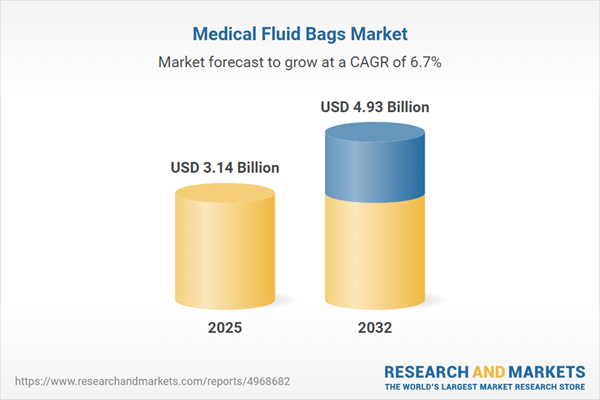Speak directly to the analyst to clarify any post sales queries you may have.
The medical fluid bags market is evolving quickly as healthcare providers demand solutions that drive safety, compliance, and reliability across diverse clinical environments. This research delivers actionable intelligence for business leaders evaluating growth strategies and innovation in this dynamic sector.
Market Snapshot: Medical Fluid Bags Market
The global medical fluid bags market expanded from USD 2.94 billion in 2024 to USD 3.14 billion in 2025 and is projected to reach USD 4.93 billion by 2032, representing a CAGR of 6.66%.
This growth is propelled by steady advancements in product design, stricter quality controls, and emerging demands from home care and ambulatory services, making it a vital segment for healthcare delivery systems worldwide.Comprehensive Scope & Market Segmentation
- Product Types: Blood bags, chemotherapy bags, parenteral nutrition bags, and saline bags—each engineered for specific storage, chemical compatibility, and clinical safety requirements.
- Materials: PVC and non-PVC substrates, including advanced thermoplastic elastomers and multilayer coextrusions that address both regulatory and performance needs.
- End Users: Hospitals, ambulatory centers, clinics, and home care providers, all with unique operational and integration challenges.
- Delivery Modes: Gravity-fed, elastomeric pump, syringe pump, and volumetric pump-compatible designs offering variable precision and flexibility.
- Sterilization Methods: Ethylene oxide and gamma irradiation, each impacting product longevity and supply chain logistics.
- Geographic Coverage: In-depth insights across the Americas (including United States, Canada, Mexico, Brazil, and others), Europe, Middle East & Africa (notably Germany, United Kingdom, Russia, United Arab Emirates, South Africa, etc.), and Asia-Pacific (China, India, Japan, Australia, and additional key markets).
- Company Analysis: Leading market participants such as Fresenius Kabi AG, Terumo Corporation, Nipro Corporation, ICU Medical, Inc., Pfizer Inc., Grifols, S.A., Vetter Pharma-Fertigung GmbH & Co. KG, Sichuan Kelun Pharmaceutical Co., Ltd., Poly Medicure Ltd., and Macopharma S.A.S. with a focus on product innovation, partnerships, and distribution strategies.
Key Takeaways for Senior Decision-Makers
- Clinical imperatives—spanning routine hydration to complex therapies—drive ongoing refinement in bag materials and design, prioritizing biocompatibility, security, and seamless device integration.
- Heightened regulatory scrutiny prompts manufacturers to prioritize safer materials and enforce stricter sterilization standards to maintain compliance and ensure patient safety.
- Shifting care models—including greater home and ambulatory care adoption—are accelerating demand for user-friendly bags compatible with smart sensors and modern infusion pumps.
- Digital monitoring capabilities within fluid bags are enabling real-time usage analytics, supporting outcome-based care and continuous R&D cycles.
- Strategic alliances, R&D investments, and select mergers are underpinning competitive differentiation, especially in regions prioritizing modernization and supply chain resilience.
Tariff Impact and Global Supply Chain Responses
The imposition of new tariffs on medical fluid bags and raw materials in the United States heightened operational costs across the value chain. Manufacturers responded with diversified sourcing strategies, regional production capacity expansions, and closer supplier partnerships to protect against future market volatility. As international trade policies evolve, such combined approaches are becoming critical for cost containment and uninterrupted supply.
Methodology & Data Sources
This analysis leverages a dual-method approach: primary interviews with procurement managers, clinicians, material experts, and regulatory authorities across varied regions, combined with thorough secondary research on industry guidelines, patent trends, and technical publications. Cross-validation against independent cost, trade, and adoption databases ensures reliability and practical value.
Why This Report Matters
- Enables informed decisions on material investments, R&D prioritization, and partnership strategies through segmented, actionable intelligence.
- Supports risk management and supply planning by providing clarity on regional dynamics, tariff impacts, and regulatory compliance.
- Assists leaders in identifying emerging opportunities and aligning product development with evolving end-user requirements and technology trends.
Conclusion
The medical fluid bags market is shaped by regulatory evolution, technical advances, and dynamic end-user needs. Senior executives can use these insights to enhance supply chain security, adapt strategies, and stay ahead in a rapidly evolving landscape.
Additional Product Information:
- Purchase of this report includes 1 year online access with quarterly updates.
- This report can be updated on request. Please contact our Customer Experience team using the Ask a Question widget on our website.
Table of Contents
3. Executive Summary
4. Market Overview
7. Cumulative Impact of Artificial Intelligence 2025
Companies Mentioned
The companies profiled in this Medical Fluid Bags market report include:- Fresenius Kabi AG
- Terumo Corporation
- Nipro Corporation
- ICU Medical, Inc.
- Pfizer Inc.
- Grifols, S.A.
- Vetter Pharma-Fertigung GmbH & Co. KG
- Sichuan Kelun Pharmaceutical Co., Ltd.
- Poly Medicure Ltd.
- Macopharma S.A.S.
Table Information
| Report Attribute | Details |
|---|---|
| No. of Pages | 192 |
| Published | October 2025 |
| Forecast Period | 2025 - 2032 |
| Estimated Market Value ( USD | $ 3.14 Billion |
| Forecasted Market Value ( USD | $ 4.93 Billion |
| Compound Annual Growth Rate | 6.6% |
| Regions Covered | Global |
| No. of Companies Mentioned | 11 |









